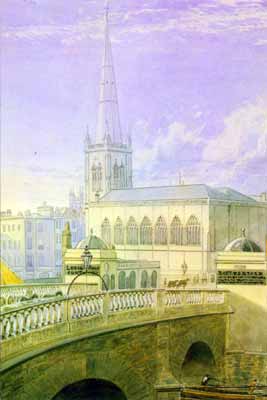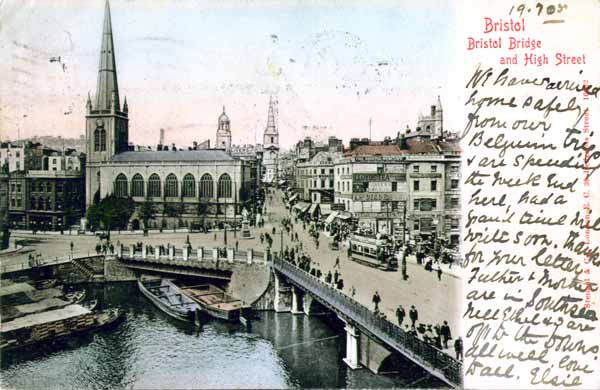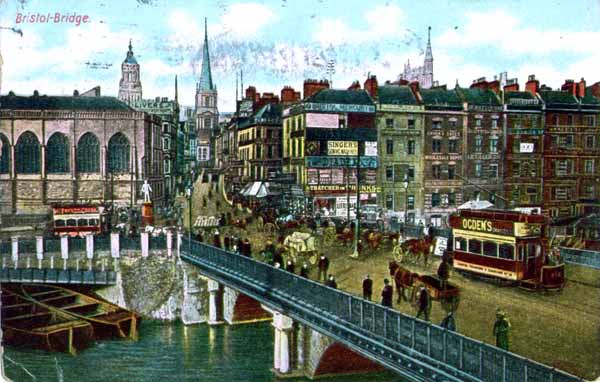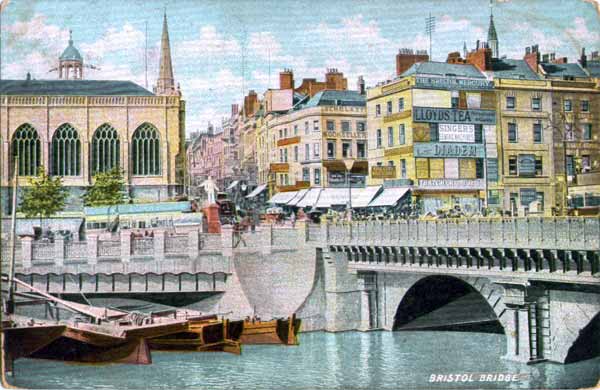
Bristol UK Postcards - Bristol Bridge

Bristol Bridge & St. Nicholas Church
Samuel Jackson - 1824
This unused postcard has the printed text...
M2176
Bristol Bridge and St. Nicholas Church in 1824
Watercolour by Samuel Jackson, 1794 - 1869
City of Bristol Museum and Art Gallery
A City of Bristol Museum and Art Gallery postcard
Printed by the City of Bristol Printing and Stationary Department (9717)

Bristol Bridge & St. Nicholas Church
This postcard, posted in Bristol on 19th July, 1905, has the printed text...
16??2
Sten??l & Co., E. C.
39 ?????? Street

Bristol Bridge & St. Nicholas Church
This postcard, posted in Clifton on 5th October, 1906, has the printed text...
The London Stereoscopic Company Series

Bristol Bridge
This postcard, posted in Bristol on 24th November, 1905, has no other printed text.

Bristol Bridge
This postcard, posted in Bristol on 21st January, 1906, has the printed text...
Hartmann trademark logo
This is the bridge that gave Bristol or Brygstowe, the place of the bridge, as it was originally known its name. The original bridge was built at the place where one could be most easily built across the River Frome.The original Saxon (approx. 600 A.D. - 1066) bridge would have been built of wood. A new bridge was built in 1247. This was still made of wood but had houses down both sides.These were five stories high that overhung the river.
By 1755 it was obvious that Bristol Bridge was no longer fit for service, it had, after all, been built in 1247, and was now over 500 years old. In 1760 a bill to replace the bridge was carried through parliament by the Bristol MP Sir Jarrit Smyth. The new bridge ws built by Thomas Paty who headed a company of commissioners between 1763 and 1768. The commissioners were allowed to collect tolls for its building and upkeep on it. After 26 years of toll collecting the comapny had over £3,000 in hand and people were clamouring for the tolls to cease. It was promised that the tolls would be scrapped on 29th September 1793, but a few days before this bills were printed saying that the tolls were available for sub-letting. The financing of the Bridge was more complicated than this though. The city taxes on its citizens were raised as were the port taxes. At this time it must be remembered that the City Council was not an elected body but a sort of "Gentlemans's Club" made up of the rich and famous. This also caused trouble in 1803 over the rebuilding of the city docks. Some members of the Council were also Commissoners for the bridge.
The financing wasn't the only problem the new bridge faced. There were heated debates about it's structure and form. Were the old foundations still stable enough? How many arches should it have? These arguments dragged on for years. In September 1761 a temporary footbridge was built but carriages and carts were soon using it. James Bridges had submitted plans for the new bridge in 1758 and after all the wrangling and arguments it was this plan that was finally adopted. The three arched bridge was built on the foundations of the old bridge first laid in 1245. The new bridge was opened in November 1768 and had cost £49,000.
In 1786, the Act that controlled the taxes and tolls expired. This Act, like the Turnpike Acts, were only in force for 21 years at a time. The Commissoners for the bridge reapplied for a new Act, this time with provision for demolishing houses on the approaches to the bridge. A corn and butter merchant, David Lewis, of Bridge Street, opposed the new Act and built up a sizable following. Following the introduction of the new Act it was David Lewis that purchased the first lease to collect the tolls on the bridge, and although he received recognition for forcing the leasing of the tolls from the Commissioners it was his tollgates that were destroyed in 1793.
It was a hanging offence to destroy even the boards on which the tolls were publicised, but on 19th September 1793 a mob gathered and destroyed the tollgates. The Herefordshire militiamen were ordered to fire a warning shot over the heads of the rioters but a 60 year old plasterer, John Abbot, who was on his way home, was killed.
The inquest of this unfortunate man shows very clearly the feelings of both sides. The Mayor initially refused an inquest, then relented but directed the coroner to return a verdict of justifiable homicide. The jury had other ideas and pronounced a verdict of willful murder by the person or persons who ordered the militia to fire. The coroner eventually returned a verdict of murder by persons unknown.
By Saturday, 28th September the tollgates were back, as were the crowd, who destroyed the new ones. The constables and troops who were sent to disperse them were pelted with stones. The next day, Sunday, the barriers on the bridge were re-erected and the Commissoners tried to collect tolls on people using the bridge. The Riot Act was read three times and in the evening the crowd dispersed.
On Monday 30th September a mob arrived in force and had the Riot Act read to them three more times. The crowd ignored this and started pelting the soldiers. The Mayor had already ordered the soldiers to fire upon the crowd if resistance was met, this they did, without any warning. Ten more people were killed, and at least another fifty wounded. Many of those hit were reported as not being part of the mob but innocent bystanders, in fact one of those killed was a man visiting Bristol on business. The reward for the soldiers was that their commander, Lord Bateman, was given 100 guineas.
There were calls for charges of murder to be brought against the Council and members of the Commissoners as well as the publishing of the accounts for the new bridge. The Council for their part insinuated that a few radicals were behind the riots rather than believe that they and the Commissoners had mishandled the situation, both in terms of the finances of the bridge and what happened in those few days in September. All of those witnesses to the riots that could be found claimed that they were there as bystanders rather than face the consequences of admitting that they took part, which is hardly surprising given that they could, if the law was exercised to its fullest extent, be executed.
The first church on the site of the present of St. Nicholas church, was founded before 1154, with a chancel extending over the south gate of the city. The gate and old church were demolished to make way for the rebuilding of Bristol Bridge and the church was rebuilt in 1762-9 by James Bridges and Thomas Paty, who rebuilt the spire. Part of the old church and town wall survives in the 14th century crypt.
The interior was destroyed by bombing in the Bristol Blitz of 1940 and rebuilt in 1974-5 as a church museum which closed in 2007 and is now used by the city council as offices.
This page created 2nd December 2009, last modified 16th March 2010